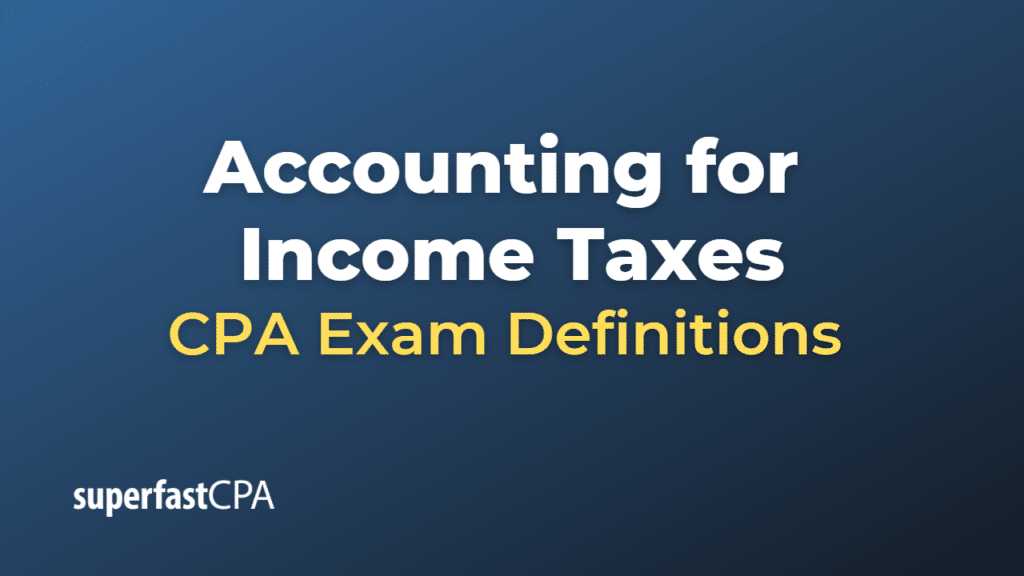Accounting for Income Taxes
Accounting for income taxes involves the proper recognition, measurement, presentation, and disclosure of income tax expense and deferred tax assets and liabilities in a company’s financial statements. The main objective is to account for the current and future tax consequences of transactions and events that impact a company’s taxable income and tax payable.
Under U.S. Generally Accepted Accounting Principles (GAAP) and International Financial Reporting Standards (IFRS), income tax accounting is governed by FASB’s ASC Topic 740 and IAS 12, respectively. Both standards require a company to account for income taxes using the balance sheet liability method, which focuses on the differences between the tax bases of assets and liabilities and their carrying amounts for financial reporting purposes.
Accounting for income taxes involves the following components:
- Current Income Tax Expense: This represents the amount of income taxes payable or refundable for the current reporting period based on the company’s taxable income, calculated by applying the applicable tax rate to the taxable income determined under tax laws and regulations.
- Deferred Tax Assets and Liabilities: These arise due to temporary differences between the tax bases of assets and liabilities and their carrying amounts for financial reporting purposes. Deferred tax assets represent future tax savings, while deferred tax liabilities represent future tax payments as these temporary differences reverse.
The process of accounting for income taxes includes the following steps:
- Calculate current income tax expense based on taxable income and the applicable tax rate.
- Identify temporary differences between the tax bases of assets and liabilities and their carrying amounts in the financial statements.
- Measure deferred tax assets and liabilities by applying the applicable tax rate to the temporary differences.
- Recognize the current income tax expense and deferred tax assets and liabilities in the financial statements.
- Reconcile and adjust deferred tax assets and liabilities considering changes in tax rates, tax laws, or temporary differences during the reporting period.
- Present the income tax expense, deferred tax assets, and deferred tax liabilities in the financial statements.
- Disclose information about the components of the income tax expense, the nature and amounts of deferred tax assets and liabilities, and any unrecognized deferred tax assets due to uncertainty in their realizability, in the notes to the financial statements.
By properly accounting for income taxes, a company provides users of its financial statements with an accurate representation of its financial position and performance, considering both the current and future tax consequences of transactions and events.
Example of Accounting for Income Taxes
Let’s consider an example of a company accounting for income taxes, including current income tax expense and deferred tax assets and liabilities.
Example: DEF Corporation has pre-tax accounting income of $300,000 for the current year. The applicable tax rate is 30%. During the year, DEF Corporation recognized $50,000 in warranty expenses for financial reporting purposes but has not yet deducted these expenses for tax purposes. The company expects to deduct the warranty expenses in the next year.
Step 1:
Calculate current income tax expense: DEF Corporation calculates its current income tax expense based on its pre-tax accounting income and the applicable tax rate:
| $300,000 (pre-tax accounting income) × 30% (tax rate) = $90,000 (current income tax expense) |
Step 2:
Identify temporary differences: The company has a temporary difference of $50,000 due to the warranty expenses recognized for financial reporting purposes but not yet deducted for tax purposes.
Step 3:
Measure deferred tax assets: DEF Corporation calculates the deferred tax asset related to the warranty expenses by applying the tax rate to the temporary difference:
| $50,000 (temporary difference) × 30% (tax rate) = $15,000 (deferred tax asset) |
Step 4:
Recognize income tax expense and deferred tax assets: DEF Corporation records the following journal entry to recognize the current income tax expense and the deferred tax asset:
| Debit: Income Tax Expense | $90,000 |
| Debit: Deferred Tax Asset | $15,000 |
| Credit: Income Taxes Payable | $105,000 |
Step 5:
Reconciliation: DEF Corporation will continue to analyze and reconcile its deferred tax asset each year until the temporary difference related to the warranty expenses reverses completely.
Step 6:
Presentation: The income tax expense is presented in the income statement, and the deferred tax asset is presented as a non-current asset on the balance sheet.
Step 7:
Disclosure: DEF Corporation should disclose information about the components of its income tax expense, the nature and amount of its deferred tax asset, and any changes in tax rates, tax laws, or temporary differences during the reporting period in the notes to the financial statements.
By properly accounting for income taxes, DEF Corporation provides users of its financial statements with an accurate representation of its financial position and performance, considering both the current and future tax consequences of transactions and events.













